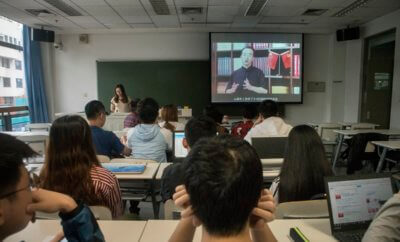Arts
A Bollywood Smash With a Twist, in China’s Cultural Battle With India

One of the most popular movies in China over the summer ran 161 minutes, so long that it was sometimes shown with an intermission. Unlike Hollywood blockbusters, there were no special effects, speeding cars or epic battle scenes. Nor was the film a Chinese production with a Chinese cast.
Instead, it won over audiences with a simple but powerful tale: the true story of a man’s quest to train two daughters to become world-class wrestlers — in India.
Featuring the Bollywood star Aamir Khan, Dangal was India’s first big hit at the Chinese box office. It took in more than $194 million in two months, making it one of the 20 highest-grossing films of all time in China. In cinemas across the country, moviegoers cheered and grew misty-eyed in one particularly moving scene as the Indian flag was raised to the tune of the Indian national anthem.
While China’s film industry has long sought both to emulate and compete with Hollywood, the runaway success of Dangal has prompted Chinese production companies to turn their gaze from West to East. Suddenly, Chinese companies are racing to snap up all things Bollywood — partnerships and distribution rights, but also Indian directors and screenwriters. And that has led to some unease.
China and India are engaged in a wary competition for regional influence and leadership. For much of the summer, the two nations were locked in a border standoff over a remote mountain pass in the Himalayas.
But more and more, the two Asian giants are also competing to project soft power — or cultural influence — outside their borders. And Dangal has revived concerns in China that it is falling behind.
“China’s development has been very comprehensive in terms of politics, economics and military,” said Jiang Jingkui, director of the Southeast Asian Research Institute at Peking University.
“But in terms of soft power, India has done better than China,” Jiang said. “Although India’s economy is not as developed, they have put a huge emphasis on promoting their culture, including things like Buddhist traditions and yoga.”
China’s anxieties about India are colored to an extent by widespread stereotyping. People here often invoke India as an example of why China, with its even larger population, is not ready for democracy.
Some call Indians “a-san,” a derogatory term that was once used to refer to the Sikh guards who worked in Shanghai’s British settlement in the late 19th and early 20th centuries. In more recent years, the public perception of India has largely been shaped by Chinese state media, which tends to highlight stories on India’s caste system and the treatment of women in Indian society.
At times, those state media reports have taken on blatantly racist overtones. In August, Xinhua, the official news agency, released a short video exhorting India to retreat from the continuing standoff at the Sikkim border. The three-minute clip featured someone wearing a turban and a fake beard in an apparent attempt to mock Sikhs, who make up a religious minority in India.
Experts say that underpinning such views is a belief widely shared among Chinese that while India may be a regional force to be reckoned with, it also lags behind China in terms of development. According to a survey by the Pew Research Center published last year, just 26 percent of Chinese hold a favorable view of India, down from 33 percent in 2006. (The feeling is apparently mutual: Another Pew Research Center survey from last year showed that just 31 percent of Indians view China favorably.)
Even today, the word that most often comes up in discussions about India is luan — or chaos.
“There’s a perception among Chinese that India is dirty and unsafe,” said Tansen Sen, a history professor at New York University Shanghai. “Even though Indian movies have been popular, Chinese tourists still don’t go to India. They would rather go to Sri Lanka or Nepal.”
Indians, for their part, are also less than enthusiastic about China. Since 1962, when the two countries engaged in a brief but bloody border war, India has been highly suspicious of China and its intentions.
While both countries have made overtures toward friendship over the years, touting their 2,000 years of contact and shared Buddhist traditions, in last year’s Pew survey, many Indians expressed concerns about a number of topics, including China’s economic impact on India (70 percent), China’s growing military power (69 percent), China’s relationship with Pakistan (48 percent), India’s main rival, and Chinese and Indian territorial disputes (69 percent).
“The newspapers in India all tend to reinforce the same view,” said Sen, who was born in India and moved to China at 14. “That is: The Chinese cannot be trusted.”
Under Prime Minister Narendra Modi, India has made it a priority to increase its cultural influence around the world. The country has sought to burnish its spiritual image by promoting itself as the birthplace of Buddhism and yoga. Indian novelists and poets have gained global name recognition around the world, even in China. There is also Bollywood, which has put Indian filmmaking on the map, while global hits like Slumdog Millionaire and, more recently, Lion, have given a prominent platform to Indian actors and stories.
Similarly, China has made no secret of its soft power ambitions. The outcome of its most ambitious soft power project to date — President Xi Jinping’s $1 trillion One Belt, One Road initiative — remains to be seen. Official news outlets like China Central Television and Xinhua have ramped up overseas operations as part of a broader effort to report global news “from a Chinese perspective.”
Some of China’s attempts to project cultural influence have stumbled. An ambitious initiative to set up Confucius Institutes on university campuses, for example, has attracted widespread criticism. And despite having made huge investments to build up its film industry, China has struggled to produce a big crossover hit since Ang Lee’s Crouching Tiger, Hidden Dragon in 2000. Even Zhang Yimou’s The Great Wall, thought to be China’s best shot in recent years at making a global blockbuster, mostly flopped at box offices outside China.
Some have come out in defense of the Chinese film industry, arguing that it is still relatively young. But the discussion around Dangal came at a time when many Chinese are expressing concerns that their film industry — in its quest to catch up with Hollywood — has become too narrowly focused on profit and entertainment over quality and substance.
“In China, the decisions are made by the people who have money,” said Gu Wancheng, senior vice president at Peacock Mountain Films, which specializes in Chinese and Indian collaborations. “But these people typically don’t have a feeling for a good story. They would rather invest in big stars or special effects.”
Perhaps going back to basics and taking lessons from Bollywood, some say, could mitigate that problem.
“In Bollywood it’s different,” Gu added. “People there have the self-confidence to say that ‘we can tell this story well.’ ”
Karoline Kan contributed research.
© 2017 New York Times News Service




You must be logged in to post a comment Login